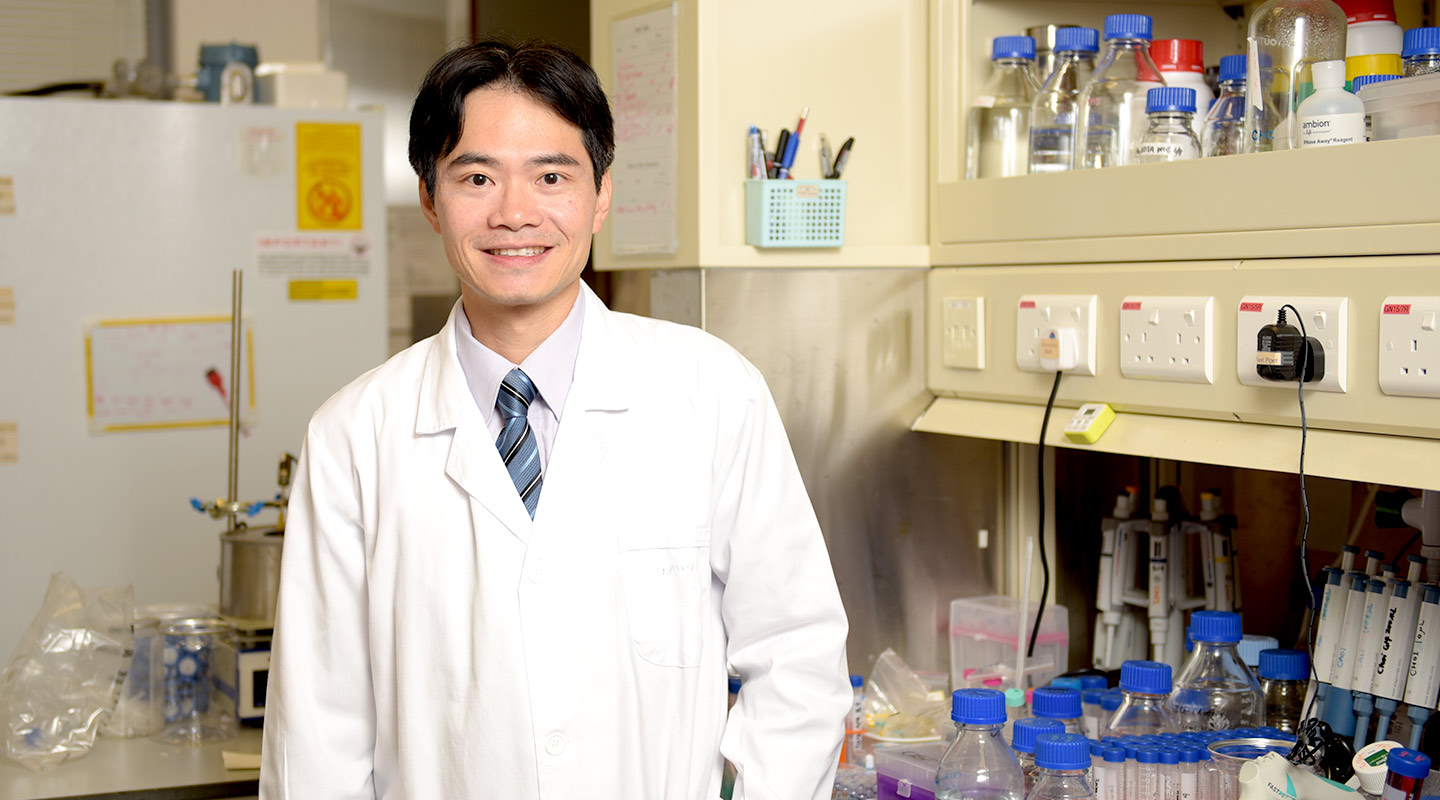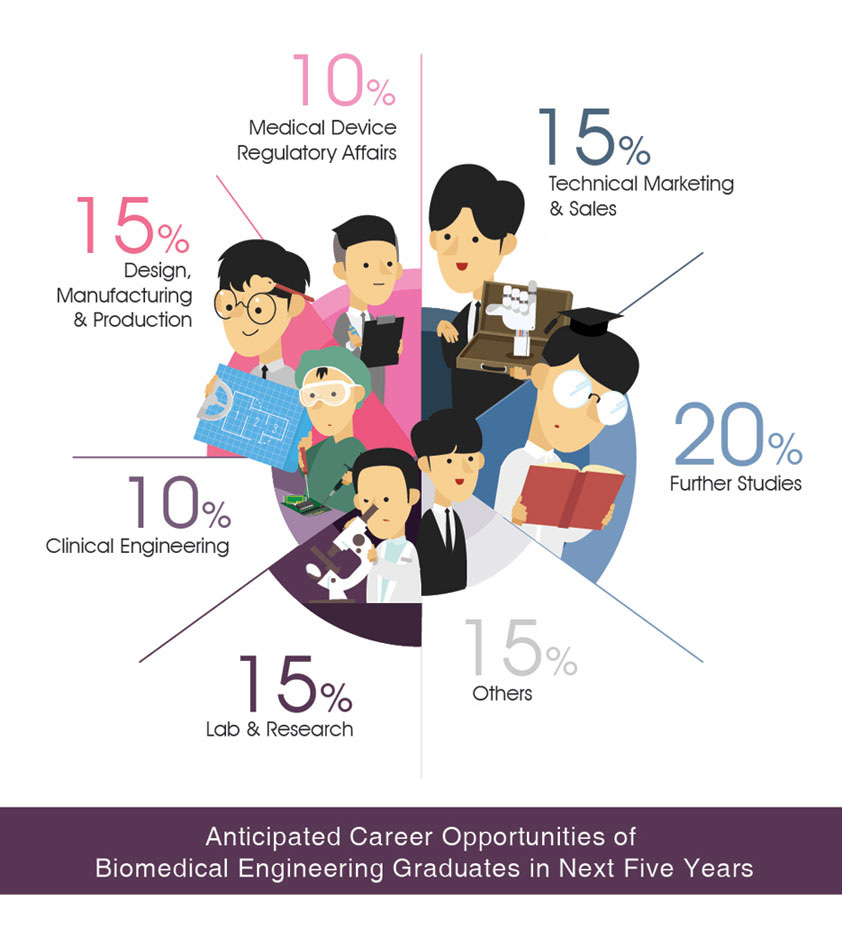Dear readers, With the launch of e-newsletter CUHK in Focus, CUHKUPDates has retired and this site will no longer be updated. To stay abreast of the University’s latest news, please go to https://focus.cuhk.edu.hk. Thank you.
The Cradle of Biomedical Engineers

Everyone gets stressed. Can stress be classified by levels? How to measure it? To answer these questions, freshmen in the Biomedical Engineering (BME) programme were asked to design a stress measuring instrument.
‘At first, we have no idea how to start. So we searched the Internet for the signs and symptoms of stress. Finally we chose respiration rate, heart rate and body temperature as the criteria. This was of course a rough assessment, but how we got the result was more important than the result itself. The project aimed at fostering our innovative thinking and problem-solving skills—the basic requirements of a biomedical engineer,’ said Suye Wong, class of 2014 of the BME programme.
Suye now works at the Electrical and Mechanical Services Department (EMSD), responsible for maintaining the medical devices of the Hospital Authority, the Department of Health, the Government Laboratory and the Prince Philip Dental Hospital.
Biomedical engineering is an emerging field that applies engineering to biomedicine so as to develop and enhance medical technologies and devices. Common technologies such as magnetic resonance imaging (MRI), angioplasty and minimally invasive surgery are the fruits of years of research by biomedical engineers.
A Programme with Competitive Edge
According to the Census and Statistics Department, the proportion of elderly aged 65 and over is projected to increase from 13% today to 30% in 2041. The ageing population and the increase in health awareness will significantly push up the demand for advanced medical devices and technologies. In response to this need, CUHK launched the BME undergraduate programme in 2010, ‘The programme aims at nurturing biomedical engineers for the rapidly rising demand,’ said Prof. Raymond Tong, the BME programme director.
‘Though under the Faculty of Engineering, the programme has a competitive edge in having a close collaboration with the Faculty of Medicine. Students have to take biology and medicine courses offered by faculty members of Medicine. They can also request professors from both Faculties to be their supervisors for the Final Year Project.’
The BME programme covers four specialty areas, namely, medical instrumentation and biosensors; medical imaging and informatics; biomaterials and regenerative medicine; and biomolecular engineering and nanomedicine. Students are free to concentrate on one of the four upon completing the foundation courses.

Blending Theory and Practice
Lizzi Cheong and Liliana Law, among the first BME cohort, pointed out that the programme not only provides both engineering and biomedical courses such as engineering mathematics, circuit theory, physiology, anatomy and biomechanics, but also emphasizes on combining the two disciplines. Lizzi said, ‘One of my projects is to modify the intravenous drip to ensure the flow rate is correct and cease operation with alarm in case of malfunction.’ Students learn their roles as biomedical engineers in advancing the medical standard by attending lectures on hospital’s daily operation, space allocation and the use of medical devices given by healthcare professionals from the Prince of Wales Hospital (PWH). What impressed Liliana most was that ‘professors led us to visit hospitals and witness the use of medical instruments from time to time.’
Professor Tong explained that the primary users of medical instruments are patients and healthcare professionals. Biomedical engineers should consider the users’ views ahead of developing new technologies and devices. He said, ‘In addition to hospital visits, we provide opportunities of learning at PWH during summer holidays. Students can also apply for the Work-Study Programme to spend six months to a year, as full-time employees in biotechnology companies, healthcare centres, medical device manufacturers or hospitals.
‘We also joined hands with renowned institutions in the UK and the US, including Imperial College, Columbia University, Northwestern University, etc., to offer 10-week biomedical engineering research attachment for our final year students.’
Frank Lo, class of 2015, was very satisfied with the arrangement. ‘Hands-on experience is a hallmark of the programme. It helped me to identify my interest in developing medical devices. Upon completing the attachment at Imperial College, I decided to pursue an MPhil in BME at CUHK. I will go to the UK for my PhD this fall.’
Lizzi agrees with Frank. She went to Columbia University to participate in a bone cell research. ‘BME is a mature discipline in the US. The trip was eye-opening for me and a wonderful experience though I may not be a researcher.’
Research Backup
The Medical and the Engineering Faculties have further collaborated in the establishing of the Chow Yuk Ho Technology Centre for Innovative Medicine to enhance knowledge transfer of innovative technologies into clinical practice for the benefit of patients. Professor Tong added, ‘The University then set up the CUHK T Stone Robotics Institute and the Institute of Tissue Engineering and Regenerative Medicine. Research findings of these institutes will not only enhance our teaching content but also contribute to a more down-to-earth curriculum.’
In Hot Demand
BME graduates like Suye and Frank naturally work as biomedical engineers or seek further studies. But there are more than that. Professor Tong said, ‘For example, hospitals require professional staff in purchasing the appropriate devices, whereas medical instrument manufacturers look for marketing executives who are familiar with the products. In anticipation of legislation for medical device regulation, the demand for expertise with biomedical engineering knowledge will increase.’
Lizzi finds another path. Upon graduation, she pursued an MPhil in medical sciences at CUHK with the goal of contributing to cancer therapy. She soon realized that legal knowledge is vital in both technology transfer and setting regulatory standards for medical devices. In 2015, she went to the Faculty of Law and read Juris Doctor. Lizzi plans to continue her studies in Postgraduate Certificate Programme in Laws in the coming September.
Currently a Year 5 medical student in CUHK, Liliana is not only interested in medicine but also likes to learn more about the need of patients. She hopes to offer personal therapy by applying what she learnt in BME.

Professor Tong said, ‘BME is viewed as one of the fastest growing professions in the US, the same as in Hong Kong. Based on the local development in BME and past employment survey, I project that the major career fields for BME graduates are clinical engineering, design and manufacturing, regulatory affairs and research. Job opportunities are ample for our graduates.’
This article was originally published in No. 497, Newsletter in May 2017.
Read More: